Gorgeous Columnar Trees: The Best 32 Tall Skinny Trees (with Pictures)

Columnar trees are ideal for adding color, beauty, and elegance to any garden landscape. Tall, skinny trees can create a stunning visual impact when they line driveways, grow along fences, or act as a privacy hedge.
Some columnar dwarf trees grow in containers and can make an attractive entrance when grown beside a doorway or gate. Their narrow, upright growth habit means that columnar trees are perfect for landscaping small and large yards alike.
The best columnar trees are:
The Italian Cypress (Cupressus sempervirens) is a fast-growing, tall, slender tree that has lush, dark green foliage.
The Emerald Green Arborvitae (Thuja occidentalis ‘Smaragd’) is a narrow evergreen tree with a pyramid shape that grows to about 15 ft. (4.5 m) tall. Commonly used as a privacy tree or hedge.
The Swedish Columnar Aspen (Populus tremula ‘Erecta’) is a deciduous, upright, narrow tree that creates a spectacular visual accent wherever it’s growing.
The Dwarf Alberta Spruce (Picea glauca ‘Conica’) is one of the most popular columnar conifers. The skinny tree has a thin pyramidal shape and is prized for its miniature nature and neat appearance.
The Red Maple ‘Walters Columnar’ (Acer rubrum) is a fine example of a columnar maple tree. This medium-sized deciduous type of tree has a slender growth habit and flowers in spring. In the fall, the tree foliage transforms into stunning shades of red.
Tall Skinny Trees for Landscaping
One of the features of columnar trees is that some of them have fastigiate branches. Fastigiate trees have branches that grow upward, almost parallel to the tree. This growth habit gives the trees an upright, straight, and thin appearance. The columnar growing pattern of these vertical trees makes them useful for planting in small gardens where space is tight.
Tall Skinny Trees for Privacy
Tall, skinny trees can be an excellent choice for privacy landscaping, as they take up less horizontal space while providing vertical screening. However, it’s essential to choose the right species for your specific conditions and to plan and maintain them properly to achieve your privacy goals.
In this article, you will learn about the best columnar trees, many of which have fastigiate growth. Along with their scientific names and pictures, descriptions of each tree will help you pick the perfect tall, skinny tree for landscaping your yard.
Columnar Trees: Tall Skinny Trees With Their Picture and Name
Although some trees are excellent for shade, narrow trees create bold statements in your yard. Some are small with dense, soft foliage and are perfect for growing along a fence. Other types of tall columnar trees are excellent for growing as specimen trees or creating a natural border along a driveway.
Columnar Oak Tree (Quercus robur ‘Fastigiata’)
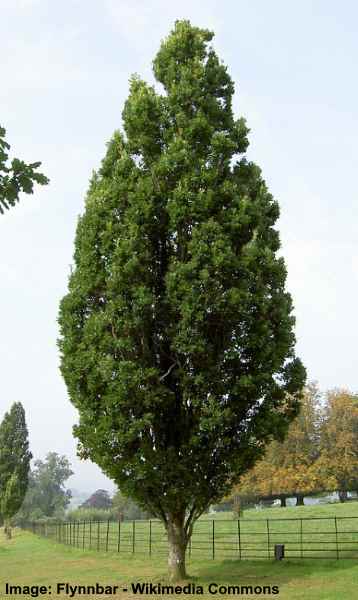
The fastigiate oak tree is a tall and fairly narrow tree suitable for large yards
The columnar oak tree grows tall and has a minimal spread, resulting in a slender, narrow tree. The tree has deciduous, oval-shaped, dark green leaves that turn an attractive golden yellow in the fall. Its trunk is short, fissured, and gray-brown in color. Additionally, it produces small, brown acorns that are a food source for birds and other mammals.
The columnar oak tree grows to between 50 and 65 ft. (15 – 20 m) tall, so it’s not a tree for landscaping small backyards. Compared to traditional oak trees, this is a slender tree with a spread of only 15 ft. (4 m). The tree is drought- and salt-tolerant, making it great for planting in arid or seaside landscapes. It can be grown as an individual specimen plant or as a hedge in larger gardens or parks.
- USDA Zones: 5 to 8
- Size: 50 to 65 ft. (15 – 20 m) tall, 15 ft. (4 m) spread
- Light Exposure: Full sun
- Soil: Well-drained soil
Narrow Kindred Spirit Oak Tree (Quercus x warei ‘Nadler’)
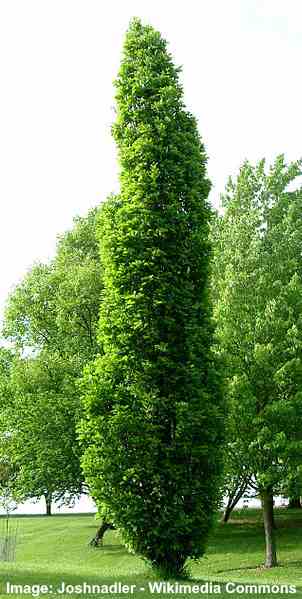
The tall ‘Kindred Spirit’ oak is a type of thin tree that will suit smaller spaces
Another stunning example of a tight columnar oak tree is the ‘Kindred Spirit’ cultivar. The fastigiate, narrow growth makes this tall, upright tree perfect for landscaping tight, compact gardens. In the fall, the dark, glossy green leaves turn a stunning red color, brightening up any autumn landscape.
The ‘Kindred Spirit’ tree is more compact than the ‘Fastigiata’ oak tree. This fast-growing deciduous tree only reaches 30 ft. (9 m) tall and has a spread of 4 ft. (1.2 m). This attractive tree can be planted in rows to create a privacy hedge or individually as an eye-catching focal point.
- USDA Zones: 4 to 7
- Size: 30 ft. (9 m) tall, 4 ft. (1.2 m) spread
- Light Exposure: Full sun
- Soil: Moist, well-drained soil
Red Maple Walters Columnar (Acer rubrum ‘Walters Columnar’)
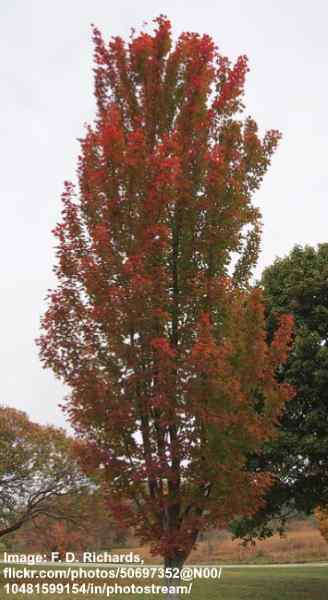
Columnar red maple trees can grow very tall and give stunning color in the fall
If you are looking for an upright, tall, columnar maple tree, then the ‘Walters Columnar’ cultivar is an excellent choice. Also called a scarlet maple, this fastigiate tree grows tall, narrow, and upright. This maple tree blooms with small, red flowers in the spring. The tree is deciduous and has lush, green foliage that turns a spectacular orange or deep red color in the fall.
Columnar red maples are excellent trees to add a bold, vertical accent to your backyard because of their growing pattern. You can also plant the trees together to create a screening hedge to protect your privacy. Because the columnar maple can reach 60 ft. (18 m) tall, pruning is required to control its height. Grow red maples in USDA zones 3 to 9.
Other columnar red maple cultivars include ‘Columnare’ with its narrow upright form, ‘Scarlet Sentinel’ which has fastigiate growth, and the ‘Armstrong’ type of columnar maple tree with silvery bark and red fall foliage. Red maples are native to the eastern United States.
- USDA Zones: 3 to 9
- Size: 60 ft. (18 m) tall, 15 ft. (4.5 m) spread
- Light Exposure: Full sun to part shade
- Soil: Slightly acidic, moist, well-drained soil
Slender Silhouette Columnar Sweetgum Tree (Liquidambar styraciflua ‘Slender Silhouette’)

Columnar sweetgums are tall, skinny trees that make a stunning vertical accent
As the name of this tree suggests, the slender silhouette sweetgum is a tall and skinny tree that belongs to the genus Liquidambar. The columnar sweetgum tree has a spread at the top about the same size as the base. The tall, slender tree, with its glossy green, deciduous foliage, looks like a bushy telegraph pole. These tall, thin trees can grow up to 50 ft. (15 m) tall and only have a spread of 5 ft. (1.5 m).
The slender silhouette sweetgum’s foliage turns beautiful shades of yellow, orange, and red in autumn. The tree also features inconspicuous yellow-green flowers, followed by spiky, woody seed capsules that remain in winter.
Slender silhouette sweetgum trees are good choices for small- to medium-sized yards where a bold, vertical accent is required. These columnar trees can also be planted together to create a tall privacy screen in your backyard. These trees thrive in full sun and in USDA zones 5 to 9.
- USDA Zones: 5 to 9
- Size: 50 ft. (15 m) tall, 5 ft. (1.5 m) spread
- Light Exposure: Full sun
- Soil: Moist, well-drained soil
Sky Pencil Holly (Ilex crenata ‘Sky Pencil’)
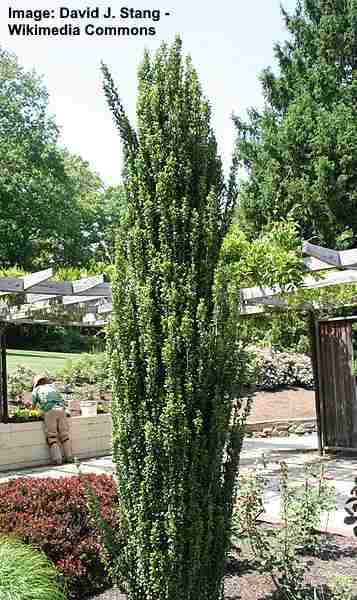
Sky Pencil holly has a narrow growth habit and is not too tall
As the name of this Japanese holly plant suggests, it has a pencil-thin growing pattern. The short growth of this narrow, columnar evergreen plant makes it an excellent columnar tree for landscaping small, compact gardens. This shrub-like, evergreen, skinny tree grows in full sun, where it reaches heights of between 6 and 10 ft. (1.8 – 3 m). The fastigiate branches grow vertically upward, making this slender tree perfect for a garden focal point.
This tall, skinny tree produces small white flowers in late summer. The ‘Sky Pencil’ trees are great for growing in a row to create a narrow hedge or privacy screen. These columnar plants are excellent for borders, growing in containers, planting along driveways, or paths. Grows well in USDA zones 6 to 8.
- USDA Zones: 6 to 8
- Size: 6 and 10 ft. (1.8 – 3 m) tall, 1 to 3 ft. (0.3 – 0.9 m) spread
- Light Exposure: Full sun
- Soil: Slightly acidic, moist, well-drained soil
Dragon Lady Holly (Ilex x aquipernyi ‘Meschick’)
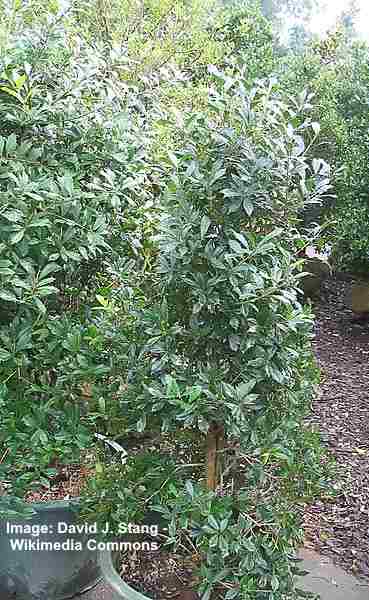
Dragon Lady holly trees are excellent for privacy
The ‘Dragon Lady’ holly tree is an evergreen tree that has a conical shape and a tall, compact growing nature. The tree has glossy, dark green leaves and small, inconspicuous white flowers. They grow to about 20 ft. (6 m) tall and have a spread of 4 to 6 ft. (1.2 – 1.8 m). There is no pruning needed to keep the narrow shape of this columnar tree. These holly trees grow just as well in the shade as in full sun.
The ‘Dragon Lady’ holly tree is perfect for planting in gardens where space is limited. The tree’s tall height and dense foliage make it an excellent choice for growing as a privacy screen. Other landscaping ideas include planting as a specimen plant, garden border, or narrow hedge. These trees thrive in USDA zones 6 to 8.
- USDA Zones: 6 to 8
- Size: 20 ft. (6 m) tall, 4 to 6 ft. (1.2 – 1.8 m) spread
- Light Exposure: Full sun to shade
- Soil: Moist, well-drained soil
Swedish Columnar Aspen (Populus tremula ‘Erecta’)

Columnar aspens are commonly used as tall, narrow windbreak trees
The pole-like growth of the Swedish aspen ‘Erecta’ makes this a stunning columnar tree. Its tall, skinny appearance gives it an attractive visual height when growing as a specimen tree. This slim aspen tree reaches heights of up to 40 ft. (12 m), which helps protect your privacy. The slender spread of this tree—as little as 8 ft. (2.5 m) across—means you can grow this pillar tree in smaller yards.
The Swedish aspen ‘Erecta’ has smooth, light gray bark and emerald green, deciduous foliage. The foliage turns a beautiful golden yellow and orange in the fall. You can also plant these narrow trees together in a row to create a tall, colorful screen or windbreak.
- USDA Zones: 2 to 6
- Size: 40 ft. (12 m) tall, 8 ft. (2.5 m) spread
- Light Exposure: Full sun
- Soil: Moist, fertile, well-drained soil
Japanese Flagpole Flowering Cherry Tree (Prunus ‘Amanogawa’)
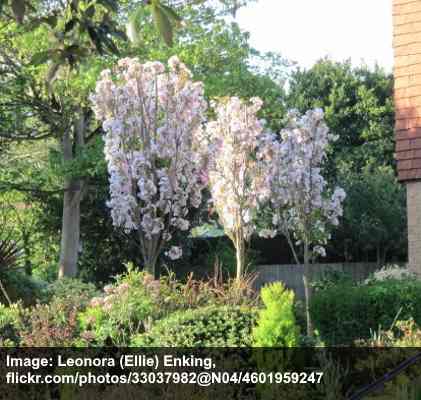
The prunus ‘Amanogawa’ has a narrow growth habit, especially in young trees
The common name of the flagpole cherry tree refers to its tall, skinny growth habit. The flowering Japanese cherry tree fills your yard with large, fragrant, semi-double pinkish-white flowers in the spring. The tree’s leaves are bright green and turn spectacular hues of orange and yellow in autumn. It also produces small, purple-red fruits. The tall, slender growth habit is more pronounced in young trees. As the cherry blossom tree matures, it takes on a more vase-like shape.
Commonly called urban fruit trees, there are several types of dwarf columnar fruit trees that can be grown in small yards. Look for varieties of plum, apple, pear, and peach trees. Apple fruit trees are true columnar trees, whereas other types of fruit trees have narrow, upright growth.
- USDA Zones: 6 to 8
- Size: 25 ft. (8 m) tall, 4 to 8 ft. (1 – 2 m) spread
- Light Exposure: Full sun
- Soil: Moist, well-drained soil
Columnar Tall Spruce Trees
Colorado Blue Spruce (Picea pungens ‘Fastigiata’)
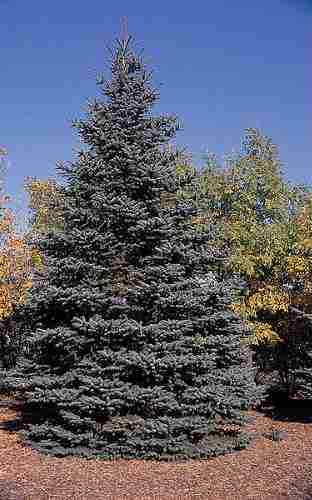
The conical, tall blue spruce is a cold-hardy, evergreen ornamental tree
Another type of conifer with a tall, upright growth habit is the Colorado blue spruce. This columnar evergreen tree is a slow grower that eventually grows up to 20 ft. (6 m) tall. The foliage of this dense tree is a bluish-green color, and its narrow, upward growth and pyramidal shape add graceful beauty to any backyard.
As with most types of spruce trees, the Colorado blue spruce is cold-hardy down to USDA zone 2b. It is also drought-tolerant, making it great for planting in xeric landscapes. Its attractive shape and foliage make it an excellent choice for planting as a focal point.
- USDA Zones: 2 to 7
- Size: 20 ft. (6 m) tall, 4 ft. (1.2 m) spread
- Light Exposure: Full sun
- Soil: Slightly acidic, well-drained soil
Colorado Spruce (Picea pungens ‘Koster’)
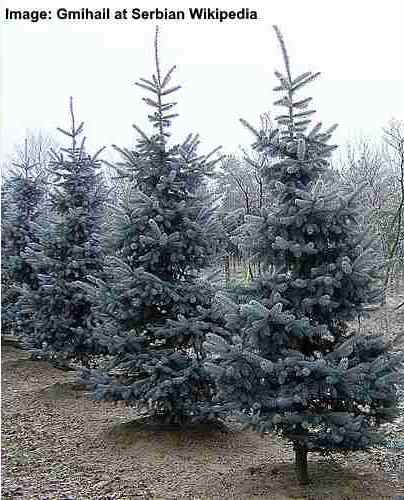
The Colorado spruce ‘Koster’ is a medium-sized evergreen tree for privacy
The ‘Koster’ Colorado spruce cultivar is a beautiful conical tree that can be identified by its gray-black bark, prickly silvery-blue foliage, and reddish-brown, cylindrical cones. This slow-growing, evergreen columnar tree keeps its shape without pruning.
The ‘Koster’ Colorado spruce provides a vertical accent when grown in containers, along borders, or as a single tree. It can even be grown as an individual focal point, adding a touch of beauty to the landscape. Grow this type of spruce in full sun in USDA zones 2 to 8.
- USDA Zones: 2 to 8
- Size: 33 to 49 ft. (10 – 15 m) tall, 8 to 13 ft. (2.4 – 4 m) spread
- Light Exposure: Full sun
- Soil: Slightly acidic, moist, well-drained soil
Columnar White Spruce (Picea glauca ‘Pendula’)

The tall and slender columnar white spruce – with its weeping nature – is great for compact yards
The columnar white spruce is an excellent example of a tall, skinny evergreen tree. The fast-growing spruce tree has drooping, pendulous branches that make the slender tree resemble a pole. The tree features attractive, densely packed dark green needles that turn a fantastic blue-green color over time.
The columnar white spruce grows in full sun and is between 12 and 40 ft. (3.6 – 12 m) tall. Plant this specimen evergreen tree wherever you need a vertical accent in a compact yard.
- USDA Zones: 2 to 6
- Size: 12 and 40 ft. (3.6 – 12 m) tall, 5 ft. (1.5 m) spread
- Light Exposure: Full sun
- Soil: Well-drained soil
Dwarf Alberta Spruce (Picea glauca ‘Conica’)
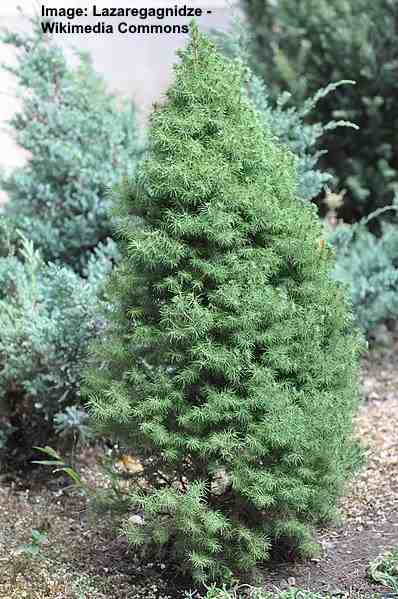
The dwarf Alberta spruce is a small, columnar tree with a slow growth rate
The dwarf Alberta spruce is an upright, skinny tree that can provide privacy due to its dense, vertical growth. This cone-shaped conifer has evergreen, light-green needles and a slow growth rate of only 4 inches (10 cm) per year. It also showcases cylindrical, pale-brown cones.
The dwarf Alberta spruce is a type of dwarf evergreen tree, and can be grown in a row to create a green privacy screening hedge. Or, you can grow the dwarf spruce in containers beside doors to create an elegant entranceway. They can also be grown as a specimen plant in the front yard due to their attractive shape.
The dwarf Alberta spruce reaches a height of 3 to 4 ft. (90 – 120 cm) after 10 years. Over several decades, it can grow to a height of 10 to 13 ft. (3 – 3.9 m). Another great feature of this plant is its cold hardiness down to -40°F (-40°C).
- USDA Zones: 2 to 6
- Size: 3 to 4 ft. (90 – 120 cm) tall after 10 years, 1.5 to 2 ft. (0.4 – 0.6 m) spread
- Light Exposure: Full sun
- Soil: Moist, well-drained soil
Columnar Arborvitae (Thuja) Trees
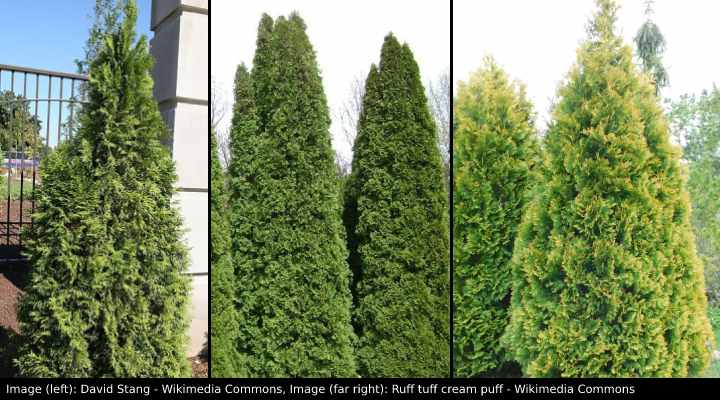
The two most popular types of arborvitae are the American arborvitae and Eastern arborvitae. The scientific name for this group of columnar conifers is Thuja. Let’s look at some of the most popular columnar conifers for creating “living walls.”
American arborvitae (Thuja occidentalis)
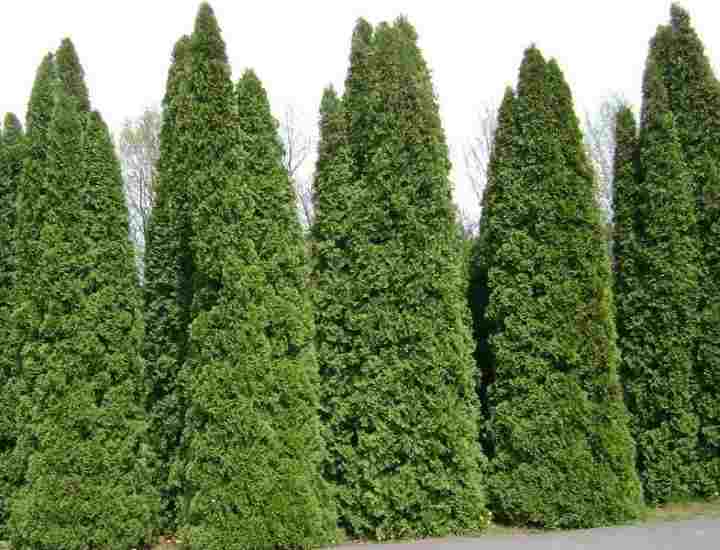
The tall, elongated pyramidal shape of these evergreen arborvitae trees makes them excellent trees for privacy fences. The soft, scaly leaves are densely packed together. Plant in a row to have year-long privacy from this low-maintenance tree.
- USDA Zones: 2 to 7
- Size: 20 to 40 ft. (6 – 12 m) tall, 10 to 12 ft. (3 – 3.6 m) spread
- Light Exposure: Full sun
- Soil: Moist, well-drained soil
Arborvitae ‘Emerald Green’ (Thuja occidentalis ‘Smaragd’)

The cultivar’s name, ‘Smaragd,’ is Danish for emerald. This semi-dwarf, skinny evergreen tree is perfect for protecting your privacy. It has a narrow, conical shape and grows to between 7 and 15 ft. (2 – 4.5 m) tall.
- USDA Zones: 2 to 7
- Size: 7 to 15 ft. (2 – 4.5 m) tall, 3 to 4 ft. (0.9 – 1.2 m) spread
- Light Exposure: Full sun
- Soil: Well-drained soil
‘Yellow Ribbon’ Arborvitae (Thuja occidentalis ‘Yellow Ribbon’)
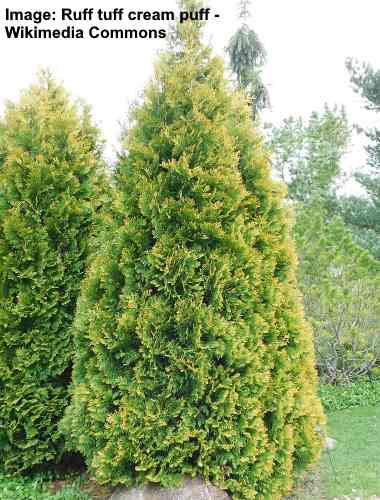
The ornamental ‘Yellow Ribbon’ arborvitae has a narrow pyramidal shape and is great as a screening hedge
Known better by its common name, American arborvitae, this columnar conifer is a tall, skinny evergreen with a pyramid shape. Soft, dense foliage makes this tree perfect for privacy screens.
- USDA Zones: 2 to 7
- Size: 8 to 10 ft. (2.4 – 3 m) tall, 3 ft. (0.9 m) spread
- Light Exposure: Full sun to part shade
- Soil: Well-drained soil
Thuja occidentalis ‘Degroot’s Spire’
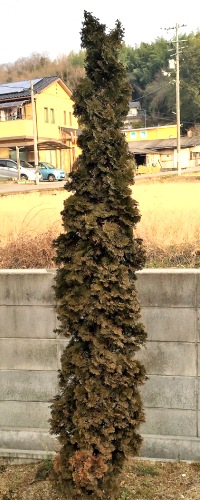
Thuja occidentalis ‘Degroot’s Spire’ is a slow-growing, evergreen conifer with a narrow, conical shape. This tree is known for its medium-green, twisted foliage, giving it a distinctive appearance.
- USDA Zones: 3 to 8
- Size: 20 to 30 ft. (6 – 9 m) tall, 4 to 6 ft. (1.2 – 1.8 m) spread
- Light Exposure: Full sun
- Soil: Moist, loamy, well-drained soil
Malonyana Arborvitae (Thuja occidentalis ‘Malonyana’)
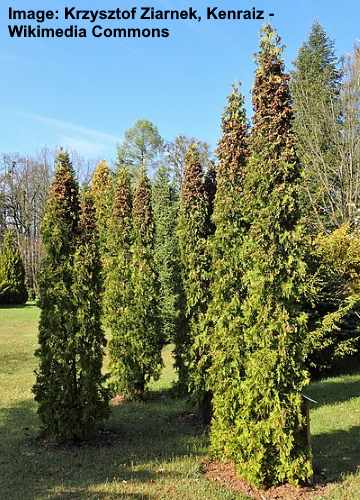
Malonyana Arborvitae (Thuja occidentalis ‘Malonyana’)
The American arborvitae ‘Malonyana’ is a tall, skinny tree with an upright, pyramidal growth habit. This narrow tree has shiny, dark green leaves and dense, evergreen foliage on short branches. Its slender, towering form makes it a perfect alternative for Italian cypress in chilly climates. The tree can be grown where a vertical accent is required or as an individual specimen plant.
- USDA Zones: 4 to 8
- Size: 20 to 30 ft. (6 – 10 m) tall, 4 ft. (1.2 m) spread
- Light Exposure: Full sun to part shade
- Soil: Moist, well-drained soil
Tall and Skinny Juniper Trees
Moonglow Juniper (Juniperus scopulorum ‘Moonglow’)

The Moonglow juniper is a decorative, narrow evergreen tree with silvery green foliage
The ‘Moonglow’ juniper tree is well-known for its neat, columnar growing pattern, attractive cone-shaped form, and dense evergreen foliage. The branches, with their soft, blue-green foliage, grow in a fastigiate way. As the tree grows, it retains its compact, columnar appearance and can eventually reach 20 ft. (6 m) tall.
This fastigiate juniper species can gracefully line driveways, paths, or grow along fences. You can also plant this as a specimen tree to create a column of dense foliage in a garden landscape.
- USDA Zones: 3 to 7
- Size: 20 ft. (6 m) tall, 6 ft. (1.8 m) spread
- Light Exposure: Full sun
- Soil: Well-drained soil
‘Blue Heaven’ Juniper (Juniperus scopulorum ‘Blue Heaven’)
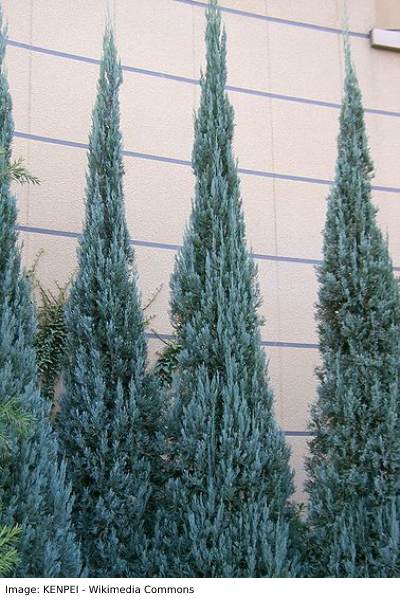
The ‘Blue Heaven’ juniper tree is a medium-sized tree known for its stunning steel-blue foliage. The tree also produces small, dark blue cones. Its distinct, narrow conical shape is due to its branches, which grow almost parallel to the trunk.
Several ‘Blue Heaven’ juniper trees can be planted as a sound barrier or privacy screen. Its attractive shape and foliage color also make it a great selection for a standalone specimen tree or front-of-house plant.
- USDA Zones: 4 to 7
- Size: 10 to 20 ft. (3 – 6 m) tall, 5 to 10 ft. (1.5 – 3 m) spread
- Light Exposure: Full sun
- Soil: Well-drained soil
Common Juniper (Juniperus communis ‘Compressa’)
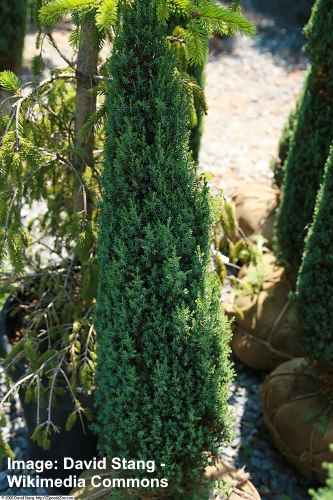
The dwarf pencil point juniper is a great tree for narrow spaces in your garden
The ‘Compressa’ juniper tree is a dwarf, narrow, columnar evergreen conifer. This tree has attractive, tightly packed blue-green needles that turn an attractive bronze shade in the fall.
The ‘Compressa’ juniper tree is perfect for compact gardens, patios, or to grace doorways. Another name for the tree is the pencil point juniper. This dwarf tree grows to between 2 and 3 ft. (0.6 – 0.9 m) tall and 1 to 2 ft. (0.3 – 0.6 m) wide. It is drought-tolerant once established.
- USDA Zones: 2 to 6
- Size: 2 to 3 ft. (0.6 – 0.9 m) tall, 1 to 2 ft. (0.3 – 0.6 m) spread
- Light Exposure: Full sun
- Soil: Well-drained soil
Skyrocket Juniper (Juniperus virginiana ‘Skyrocket’)
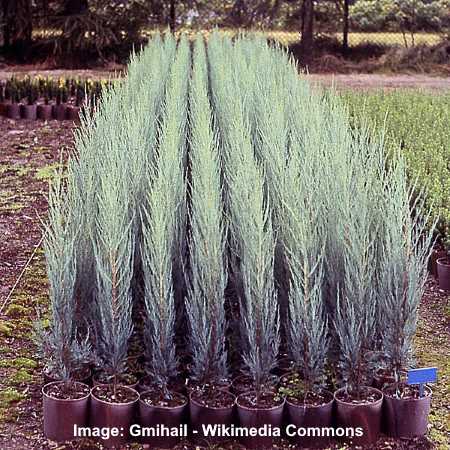
The ‘Skyrocket’ juniper is a stunning, elegant columnar tree that is characterized by its narrow growth and attractive, evergreen silvery-blue foliage. Additionally, female trees produce ornamental, round gray-blue fruit. This juniper is cold-hardy down to -30°F (-34°C) and is drought-tolerant once established.
The ‘Skyrocket’ juniper is perfect for planting in groups to create an attractive evergreen privacy screen. Its height and attractive foliage also make it a good choice for planting as an individual focal point.
- USDA Zones: 3 to 9
- Size: 25 to 35 ft. (7.6 – 10.6 m) tall, 6 to 8 ft. (1.8 – 2.4 m) spread
- Light Exposure: Full sun to partial shade
- Soil: Well-drained soil
Spartan Juniper (Juniperus chinensis ‘Spartan’)
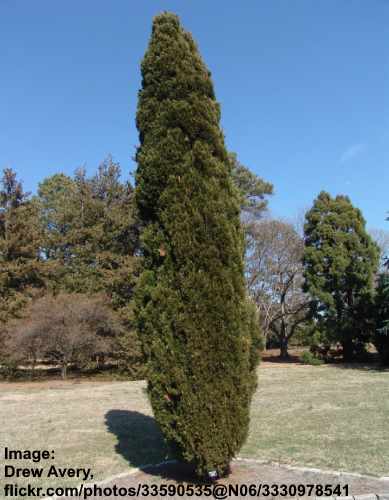
The ‘Spartan’ juniper is a fast-growing, narrow tree with a natural, symmetrical, columnar shape. The tree features bushy, dark green, scaly foliage. It can be planted as an evergreen privacy screen, a formal accent tree, or a windbreak. The tree makes a wonderful vertical accent or specimen plant.
- USDA Zones: 4 to 9
- Size: 15 to 20 ft. (4.5 – 6 m) tall, 4 to 5 ft. (1.2 – 1.5 m) spread
- Light Exposure: Full sun
- Soil: Moist, well-drained soil
Red Cedar (Juniperus virginiana)
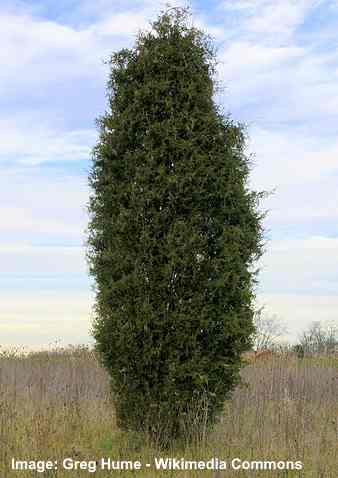
Red cedar (red juniper) is a slow growing tall evergreen coniferous tree. It’s not a true type of cedar tree.
The red cedar has a columnar growth nature and is also called the red juniper. This slow-growing conifer has a slightly rounded shape. It is known for its scaly foliage that comes in shades of blue-green or dark-green. The striking appearance of the eastern red cedar has been described by some people as an exclamation point in the garden landscape. These evergreen tall columnar trees keep their color all year long.
Although known as the red cedar, this tree is not a true cedar as it’s a species of juniper tree native to eastern North America.
- USDA Zones: 2 to 10
- Size: 40 to 50 ft. (12 – 15 m) tall, 8 to 20 ft. (2 – 6 m) spread
- Light Exposure: Full sun
- Soil: Well-drained soil
Brodie Eastern Red Cedar (Juniperus virginiana ‘Brodie’)

The ‘Brodie’ cedar is a drought-resistant columnar tree which can be used to create a privacy hedge for screening neighbors out
The Brodie cedar (often referred to as Brodie juniper) is a medium-sized tree with a narrow, evergreen pyramidal shape. It is a smaller and more compact cultivar than other junipers. Due to its tall, skinny growth habit, these junipers are also called pencil junipers.
Brodie cedars grow in a wide variety of climates. They are very drought-resistant plants that grow in full sun and up to 25 ft. (7.5 m) tall. Plant several eastern Brodie cedars together to create a privacy screen. They can also be used as a focal point or specimen plant.
- USDA Zones: 6 to 9
- Size: 25 ft. (7.5 m) tall, 4 to 6 ft. (1.2 – 1.8 m) spread
- Light Exposure: Full sun to part shade
- Soil: Well-drained soil
Tall Skinny Evergreen Eastern Red Cedar ‘Taylor’ (Juniperus virginiana ‘Taylor’)

‘Taylor’ red cedar is a slender evergreen tree that doesn’t take much space
The eastern red cedar cultivar ‘Taylor’ is a tall, columnar tree with evergreen, dense, blue-green foliage. In winter, the leaves may transition into an attractive reddish-brown hue, adding to the tree’s beauty. Some landscaping ideas for this tree include growing as a formal screen, hedgerow plant, or evergreen privacy edge. It can also be planted as a specimen.
- USDA Zones: 4 to 9
- Size: 15 to 20 ft. (4.5 – 6 m) tall, 3 to 4 ft (0.9 – 1.2 m) spread
- Light Exposure: Full sun
- Soil: Well-drained soil
Hinoki Cypress (Chamaecyparis obtusa ‘Nana Gracilis’)
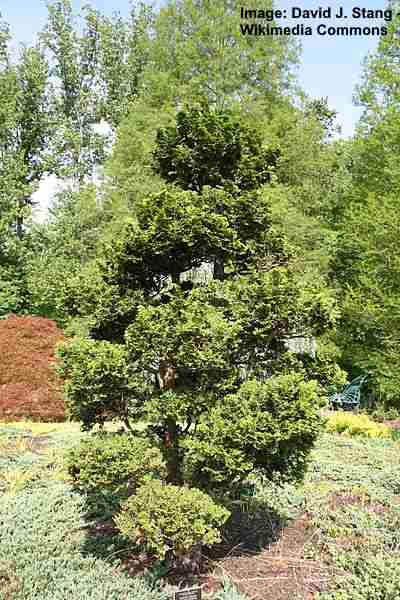
The Hinoki cypress is a small narrow tree that can be grown as a privacy hedge
The Hinoki cypress tree is a dwarf variety with a compact growing nature. It has more of a round shape when young, and a pyramidal shape as it grows older. The tree features shiny, lush dark green foliage. This slow-growing tree will take about ten years to reach 3 ft. (1 m) tall. Over time, the pyramid-shaped slender tree reaches heights of between 6 and 9 ft. (1.8 – 2.7 m).
The cultivar name ‘Nana Gracilis’ literally means slender or graceful dwarf. Grow in full sun wherever you need a small living hedge. Other planting ideas are to grow the columnar tree in a container on a patio or beside a front door.
- USDA Zones: 4 to 8
- Size: 6 to 9 ft. (1.8 – 2.7 m) tall after some time, 2 to 4 ft. (0.6 – 1.2 m) spread
- Light Exposure: Full sun
- Soil: Moist, well-drained soil
Tall Skinny Italian Cypress (Cupressus sempervirens)
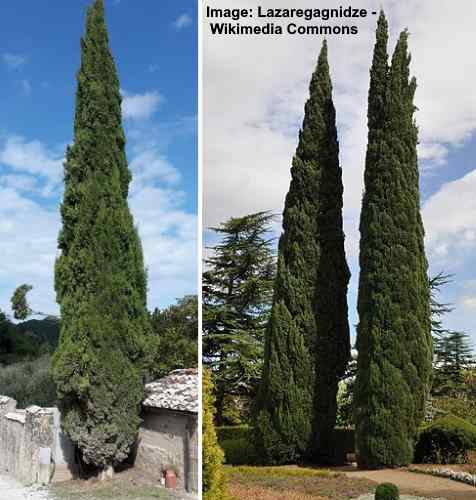
The tall narrow Italian cypress gives a stunning focal point in the landscape
Also called the pencil pine due to its tall, skinny appearance, the Italian cypress is a fast-growing, narrow evergreen conifer. The tree has dark-green foliage that grows in dense sprays. These tall, upright narrow evergreen trees look like huge poles that taper to a point. The fastigiate species of Italian cypress trees have erect and vertical branches that grow close to the trunk.
Due to its tall, thin appearance, the Italian cypress tree is deal for protecting your privacy, and making a bold statement wherever it grows. The standard cypress trees grow 40 to 70 ft. (12 – 21 m) tall. However, if space is limited in your backyard, you can grow dwarf varieties of this plant that just grow to 9 ft. (2.7 m) and are about 1 to 2 ft. (30 – 60 cm) wide.
- USDA Zones: 7 to 9
- Size: 40 to 70 ft. (12 – 21 m) tall, 10 to 20 ft. (3 – 6 m) spread
- Light Exposure: Full sun
- Soil: Moist, well-drained soil
Lombardy Poplar (Populus nigra)
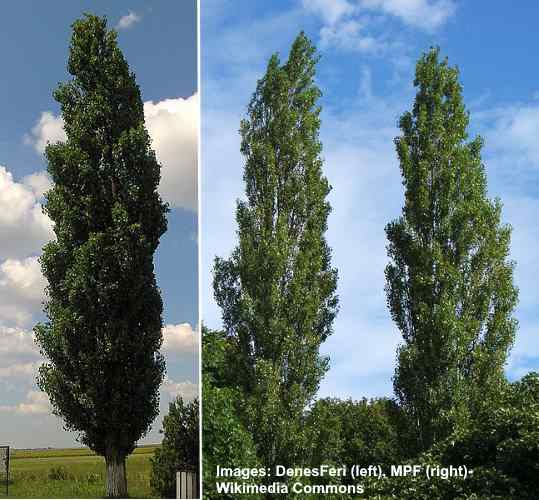
The Lombardy poplar is a common columnar tree for blocking wind in large yards
The Lombardy poplar is a deciduous tree that grows rapidly in warm climates—expect growth of about 3 ft. (1 m) per year. These majestic, erect trees can eventually grow up to 50 ft. (15 m) and grow for 20 years. Poplar trees produce slim cylindrical flowers called catkins. The leaves are deciduous, diamond- to triangular-shaped, and bright green in color. These columnar deciduous trees are excellent plants for windbreaks, screens, or to grace long driveways. They grow well in USDA zones 3 to 9 and need full sun to grow tall.
- USDA Zones: 3 to 9
- Size: Up to 50 ft. (15 m) tall, 10 to 15 ft. (3 – 4.5 m) spread
- Light Exposure: Full sun
- Soil: Well-drained soil
Columnar Norway Spruce (Picea abies ‘Cupressina’)

The columnar Norway spruce is an attractive evergreen tree with a tall, skinny growth habit. Its dense, fastigiate branches feature dark green leaves that turn an attractive blue-green hue during winter. The tree also produces small, cylindrical, reddish cones.
The columnar Norway spruce can be used to add a vertical accent to larger gardens or parks. Its dense foliage also makes it ideal for planting as a sound barrier or privacy screen. The spruce’s elegant form and year-round greenery make it an excellent, low-maintenance choice for landscaping projects that desire both aesthetics and practicality.
- USDA Zones: 3 to 8
- Size: 19.6 to 23 ft. (6 – 7 m) tall, 6 ft. (1.8 m) spread
- Light Exposure: Full sun
- Soil: Moist, well-drained soil
Hicks Yew (Taxus x media ‘Hicksii’)
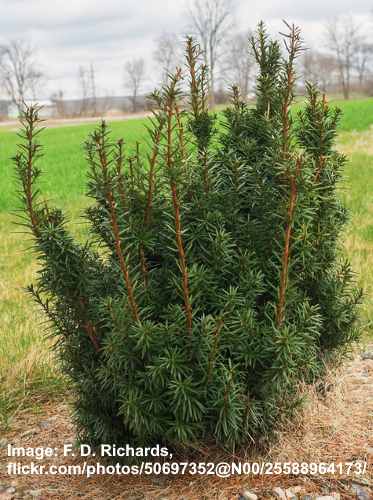
Hicks Yew (Taxus x media ‘Hicksii’)
The Hicks yew is an evergreen conifer with a narrow, columnar growth habit. The tree features shiny, dark green needles that are pale green on the undersides. The tree’s growth habit becomes wider and more round as it grows older. With its slender growth, this tree is a great choice for tall hedges, privacy screens, or as a container plant. This tree’s upright, columnar growth is ideal for enhancing the corner of a house. Additionally, it is drought-tolerant once established.
- USDA Zones: 4 to 7
- Size: 10 to 12 ft. (3 – 3.6 m) tall, 4 ft (1.2 m) spread
- Light Exposure: Full sun
- Soil: Well-drained soil
Japanese False Cypress (Chamaecyparis pisifera ‘Soft Serve’)
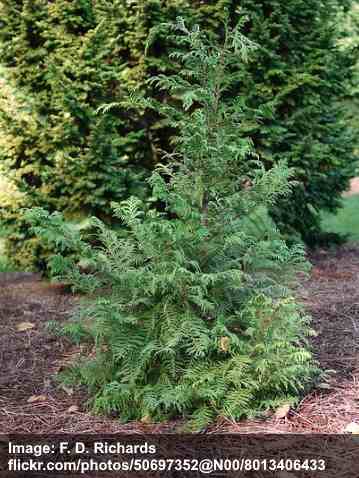
If you have a small garden, then Japanese False Cypress is considered one of the best space-saving privacy fence trees
The Japanese cypress ‘Soft Serve’ is a medium-sized conifer with a dense, pyramidal shape. The tree has feathery, bright green or yellow green leaves with distinctive, silver-blue specks on the undersides. This attractive evergreen tree can be grown as a foundation plant, specimen plant, or privacy hedge.
- USDA Zones: 4 to 8
- Size: 6 to 10 ft. (1.8 – 3 m) tall, 5 to 6 ft. (1.5 – 1.8 m) spread
- Light Exposure: Full sun to part shade
- Soil: Well-drained, moist soil
Related articles:
- 15 Small or Dwarf Evergreen Trees For Your Garden
- Types of Beautiful Flowering Trees with Pictures
- The Best Privacy Trees: List of Great Privacy Fence Trees
